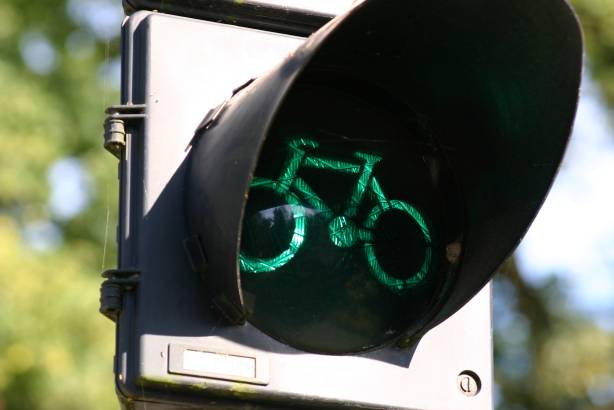
With the push for more bicycle infrastructure and a corresponding increase in cyclists, a tug of war has begun. This struggle has more to do with personality and style than function; it is a defining characteristic of each cyclist, namely, what sort of attire to wear when riding a bike.
Most cyclists and non-cyclists are familiar with the main cycling stereotypes. There is the bike racer wannabe who dresses in full kit like he is headed for the Tour de France — even though he only rides on weekends with his friends. Then there is the urban cyclist who dresses in jeans and boots or sneakers. He weaves in and out of traffic, annoying drivers with his quick maneuvers and antics. One step up from the urban cyclist is the hardy commuter who wears hi-viz clothing over street clothes. Let’s not forget the casual cyclist who outfits her bike with a pretty basket and a bell and rides slowly on a bike path or alongside a road.
These distinct styles aren’t just about fashion. They’re about something much more important — the effect riding attire and riding style have on cyclist safety.
Cyclists have different perceptions about how dangerous riding is and how likely they are to crash or get hit by a car. Estimates based on such perceptions can be way off because there is an element of uncertainty. Fate can place a cyclist in the wrong place at the wrong time. Anticipating such a situation is impossible.
Racer types never seem to see themselves as being in danger. Urban cyclists ride recklessly, without a care in the world. They take a “come what may” attitude and disregard any risks. Commuters often make themselves as visible as possible through the use of bright clothing and lights. And casual cyclists seem unaware of how invisible they are on the road when they ride without high visibility clothing or lights.
Clothing and gear can go a long way in making a cyclist safer. But many cyclists don’t want to wear screaming yellow clothes or add all kinds of lights to their bikes.
As a result, the market for cycling safety products is changing. Designers and manufacturers are beginning to recognize the need for safety gear that doesn’t look like safety gear. After all, some people don’t like to look as if they work on a road crew.
To that end, I recently received an e-mail from a company who manufacturers messenger bags. These bags are hand-crafted in the USA, in San Francisco, to be precise.
I’m on their mailing list because I once bought something from them and I didn’t opt out of receiving information from their company. I don’t always read the e-mails they send to me, but the subject of their latest e-mail caught my eye. It read: “A glowing messenger bag: 30-days to Kickstart us, plus, love, 500 miles and other bright ideas.”
How can you not notice a subject line like that? I read on: “Be safe and be seen. Back our fist Kickstarter project for a glowing messenger bag. We’re excited to announce the Halo Zero, our newest project in collaboration with Halo Belt to create an LED illuminated messenger bag to keep you safe, and increase nighttime visibility.”
A glowing messenger bag: who would have thought that this would be conceived of, let alone produced? The company behind this innovative product is none other than Rickshaw Bagworks who hand makes a line of urban bags, one at a time.
Craftsmanship of this sort is difficult to find today. Most products are haphazardly made on an assembly line to keep prices down. The quality of these products varies, but it’s rarely very good. Consumers may save some money, but they have bought something that may not last very long. A more expensive product is well worth the price because the superior quality of an individually made item shows in the final product and increases durability.
On their Kickstarter page they explain themselves this way: “The name of our company derives from three Japanese characters meaning “human powered vehicle”–delightfully apropos for a company making bags for bicycle enthusiasts, and our metaphor for the strength of the human spirit.”
The glowing messenger bag looks like their medium sized bag with an illuminated strip across the outward facing side of the bag. The strip can glow or flash and I read that it’s removable in case a cyclist would prefer to wear it on his or her clothing.
If this project gets off the ground, it will be among the first to combine function and fashion with bike safety. The bags are very cool and can be used on and off of a bike. In the daytime, the bag looks like a normal messenger bag. Yet at night, it can operate as a safety light.
Another advantage of this approach to safety is eliminating theft of bicycle lights. Either a cyclist must remove and take all lights with him, or he must leave the lights on an unattended bike and hope that no one steals them.
Full funding of this project is likely. Rickshaw Bagworks has a large following among cyclists and urban dwellers. Those followers have reasons for supporting them. Not only do products of this type provide more safety options for cyclists, but they keep jobs here in the USA. And, it’s nice to buy something made in the USA for a change.
Hopefully, this will be the first step in starting a trend towards integrating cycling safety gear in clothing and other items cyclists carry with them. Offering integrated products will bridge the gap between full fledged hi-viz cycling attire and street clothes invisibility.
As such products become the norm, so too will cycling. Combining everyday items with cycling needs will serve to make cycling a typical part of daily life.



